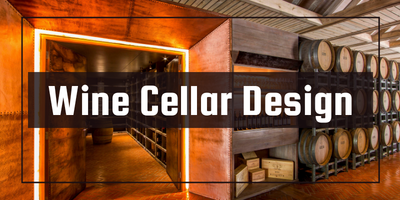
5 Signs Your Wine Cooling System Is About to Fail
Don’t wait for a costly surprise. Wine Guardian Dealer breaks down the top 5 signs your wine cooling system may be failing — and how to fix it before damage...
Jim Hopper
In Stock & Ready to Ship – Order Your Wine Cooling System Today!
Free Wine Cellar Expert Consultation | 📞 Call 1-800-260-1712
Start with a free expert consult—cooling system sizing, racking options, and no upsells.

Build your dream wine cellar—without costly mistakes or guesswork.
By Jim Hopper, Wine Cooling Expert

Have an attic that’s just collecting dust (and maybe old Christmas decorations)?
Here’s an idea: turn it into your dream wine cellar. 🍷
It might sound crazy—but with the right insulation, layout, and cooling system, you can absolutely build a wine cellar in the attic. In fact, it’s becoming a popular trend among homeowners who want to repurpose unused space and add serious wow factor to their home.
In this article, we’ll cover:
Before you grab the ladder, get expert insights from our full Wine Cellar Design and Installation: Build a Beautiful, Functional Wine Room That Lasts to plan it right from the start.
Let’s climb up and take a look.
Most people think of basements when they think of wine cellars—but not everyone has one. And let’s be honest, the attic offers a unique, tucked-away space with major potential.
But there’s one big thing to keep in mind…
The biggest challenge with attic wine cellars is temperature control. Attics tend to:
🔥 In summer, attic temps can exceed 120°F—far from the 55°F your wine needs. To address these challenges, wine cellar cooling units are essential for maintaining the optimal climate in your attic wine cellar. So while attic wine cellars can work, they require careful planning and the right equipment.
When it comes to designing and installing a wine cellar in an attic space, there are several location considerations to keep in mind. Attic wine cellars can be a great way to utilize unused space, but they require careful planning to ensure optimal wine storage conditions.
First, consider the structural integrity of your attic. Ensure that the floor can support the weight of your wine collection, racks, and cooling system. Consulting with a structural engineer can provide peace of mind and prevent future issues.
Next, think about accessibility. A wine cellar in the attic should be easily accessible, yet secure. Consider installing a sturdy staircase or ladder and ensure that the entrance is wide enough to move wine racks and bottles comfortably.
Finally, consider the proximity to utilities. Your cooling system will need a reliable power source, and you may also need plumbing for a humidifier. Ensuring that these utilities are easily accessible can simplify installation and maintenance.

Here’s a checklist of what you need to do before installing racks and moving bottles:
Seal all air leaks tightly to prevent cold air loss and maintain consistent conditions.
This is non-negotiable. Attics are exposed to direct heat from the sun.
📘 Related: Wine Cellar Insulation Guide
A vapor barrier helps prevent moisture migration, which can mess with humidity levels and damage walls. It must be applied to the warm side of the insulation to prevent moisture transfer and condensation.
This is the heart of your attic wine cellar. You’ll need a cooling unit that:
A split cooling system is particularly advantageous as it features the compressor outside, ensuring a quiet and vibration-free environment.
We’ll cover your best system options below 👇
Choose low-heat LED lighting and avoid skylights or exposed windows.
Consider light-colored finishes to reflect heat and create a bright, stylish look. Lighting should come from a low wattage source and avoid bright lights for long periods of time to protect the wine.
📘 Related: Attic Wine Cellar: Real-World Build Example
When designing an attic wine cellar, it’s essential to consider the type of doors and windows to use. Exterior-grade doors with dual-pane insulated glass and tight-fitting closure hardware are recommended to maintain temperature and moisture exchange. Windows should also be high-quality, insulated, and designed to prevent heat transfer. Consider using glass panels or skylights to allow natural light into the space while maintaining temperature control.
Choosing the right doors and windows can significantly impact the efficiency of your wine cellar cooling systems. Properly insulated doors and windows help maintain the perfect environment for your wine collection, ensuring that cool air stays in and warm air stays out.
Designing a wine cellar requires careful consideration of several factors, including cooling unit features, insulation, and ventilation.
Not all cooling systems can handle attic conditions. Here are the top picks from WineGuardianDealer.com:

👉 Explore Pro Series Split Systems

👉 Shop Sentinel Series Ducted Systems

When selecting a cooling unit for your wine cellar, consider the following features:
Choosing the right cooling system is essential for creating the perfect environment for your wine collection. Whether you opt for a self-contained unit, a split system, or a ducted system, ensure that it meets the specific needs of your attic wine cellar.
Regular maintenance and upkeep are crucial to ensuring your attic wine cellar remains a perfect environment for wine storage. Here are some tips to keep in mind:
By following these tips and considering the unique challenges of attic wine cellars, you can create a perfect environment for your wine collection to thrive. Regular maintenance and attention to detail will ensure that your wine cellar remains a valuable and enjoyable part of your home for years to come.
“We had a low-ceiling attic we never used, so we turned it into a wine cellar with cedar racks and a Wine Guardian split system. It stays cool even during summer—and the view from our tasting nook is incredible.”
— Maya L., Upstate NY
“I was skeptical about cooling an attic, but after insulating the space and installing a ducted Wine Guardian unit, it works beautifully. My wine’s safe—and it’s become a conversation piece when guests come over.”
— Jake T., Austin, TX
Your attic has more potential than you think. With the right plan—and the right Wine Guardian system—you can create a stunning space that keeps your wine perfectly preserved.
👉 Shop Wine Guardian Cooling Systems
Explore ducted and split systems built to handle the unique challenges of attic environments.
📞 Call 1 (800) 260-1712 for a FREE custom consultation
We’ll help you choose the right unit, insulation specs, and accessories for your attic project.
Yes, but only with proper insulation and a dedicated cooling system.
Split systems are often ideal because they keep the compressor outside and reduce heat inside.
In many cases, yes—attics tend to be dry. A Wine Guardian humidifier helps keep RH in the 60–70% range.
It depends on insulation and cooling needs, but most fall between $15,000–$30,000+ for a finished attic wine room.
Parts of it—yes. But we recommend professional installation for your cooling system to ensure performance and warranty coverage.
🛒Shop our most-loved Wine Guardian cooling systems today.
🛠️Protect your wine with the most trusted systems on the market.
❤️Tested, reviewed, and loved by serious collectors like you.